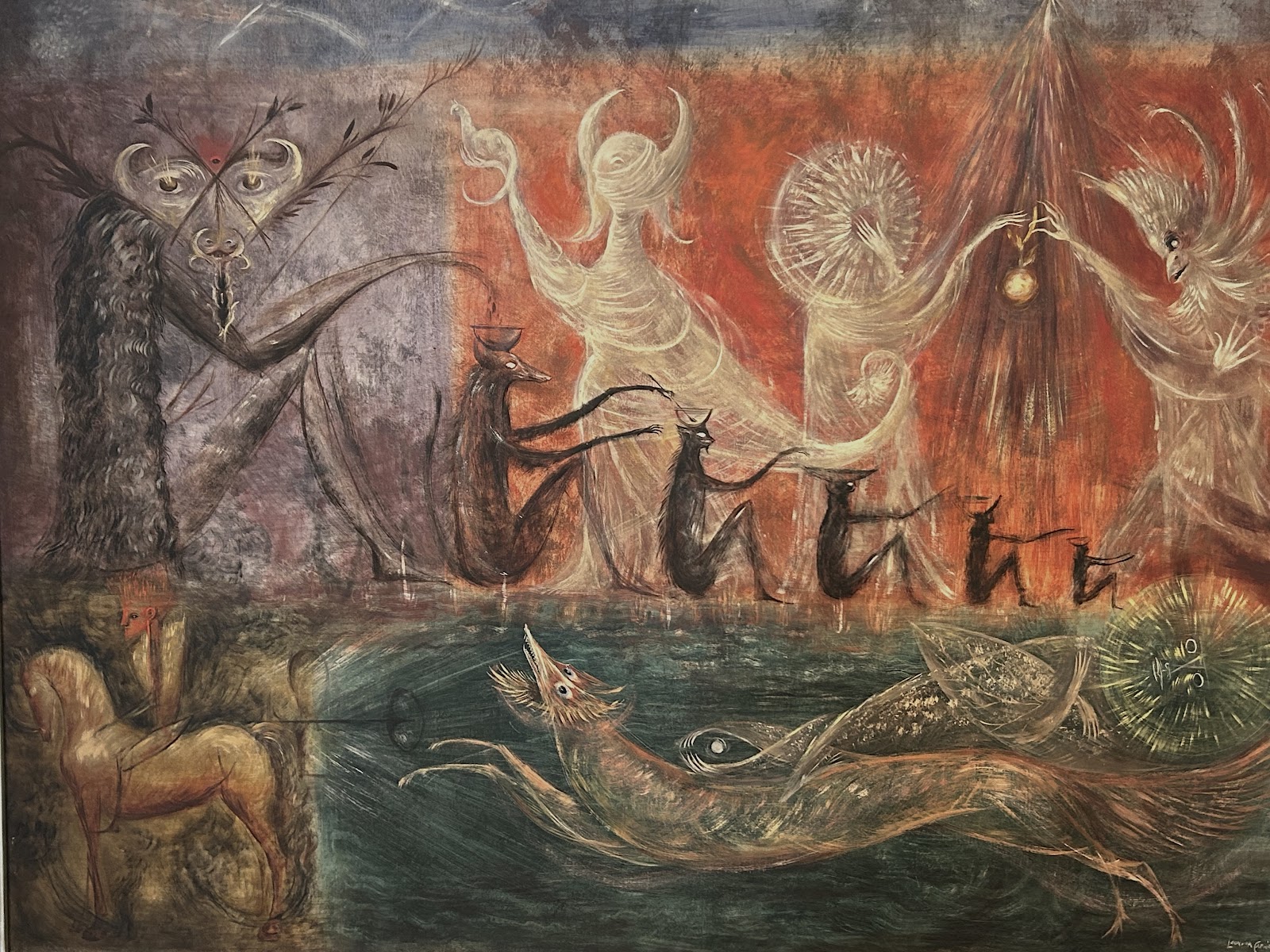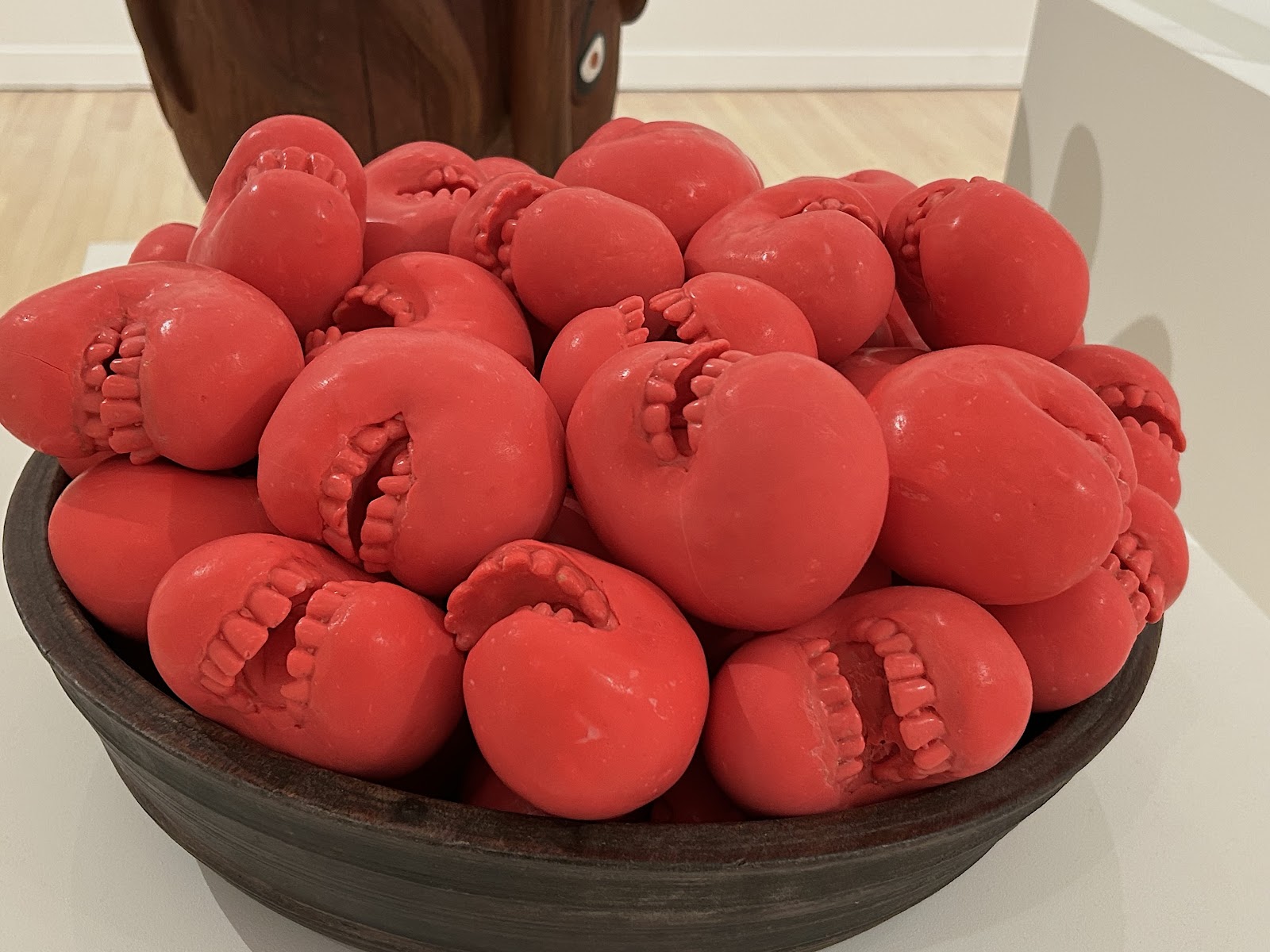Carrington, The Last Resort (homage to Mexico?)
Leonora Carrington: Dream Weaver
Hugh Hayden: Home Work
Surrealism Then and Now
(All through June 1, 2025)
Rose Art Museum, Brandeis University
415 South Street, Waltham, Massachusetts
Wednesday-Sunday 11-5
I had never been to the Rose Art Museum or the campus of Brandeis University before. Although it’s inside Route 95/128 and is now considered a Boston ‘burb, you pretty have to drive to it as the MTA won’t get you near enough. If you go on a weekend, though, it’s an easy drive back to Alewife where you can stash your car and ride the Red Line into Boston. I took a chance and drove into Harvard Square where, miraculously, I found a parking spot.
 |
| Pastoral 1950. Note the wink to Manet's dejeuner sur l'herbe |
The main objective was the see paintings and drawings of Leonora Carrington (1917-2011), who was born in England but spent most of her life in Mexico. She came from wealth but rejected bourgeois society and English culture but, then again, there wasn’t much she did rebel against. She was influenced by German surrealist Max Ernst and upon meeting him, the two became lovers that very night.
 |
| Nephesh as the Soul in a State of Sleep (dreams, the soul, the Kabbala all in one!) |
Carrington is often considered that last of the surrealists, though that’s a problematic handle and many consider her more of a symbolist like Paul Gaugin or Odilon Rédon. There’s quite a lot of that in Carrington’s work, her major themes being nature, animals, myth, and the female body. (She would later identify with women’s liberation.) Yet her work also fits surrealist ideas of dreams, emotions, and the subconscious mind with all of its illogic and troubling aspects. Unlike most surrealists, though, she had no interest in Freud; like some of them, she had a psychotic breakdown (treated with electroshock, and barbiturates), and like many sought asylum in Mexico during World War Two. She and Ernst split when he was arrested by the Nazis as a “degenerate.” Peggy Gugenheim got him to the United States and married him! Carrington took up with a poet, whom she married and divorced.
Here are a few more works on display at the Rose. In my mind it doesn’t matter if she doesn’t fit snugly in any art movement. She was fiercely independent and I suspect she was doing her own thing, as we used to say back in the day.
 | ||
| Nunscape at Manzanillo |
 | ||||
| Noah's Ark. (He has too many deer!) |
uuuuuuuuuuuuuu uuuuuuuuuuuuuu
The Rose is, however, spotlighting surrealism in a broad sense. Also on display is the intriguing work of Dallas-born Manhattanite Hugh Hayden (1983-). His acclaimed Home Work series shows him working in his favorite medium, wood. He adorns desks in thorns and branches growing on them and through them as if the desks are the Ur root of a living thicket. Hayden enjoys the irony and whimsy involved in taking familiar objects and transforming them.
He doesn’t always work in wood, though. Another series involves taking cookware and making them into masks, displaying bones as a playful take on “American Gothic,” or make think of Siberia through the use of a small hut and a several big mirrors. I suppose we could label this surrealism, though we might just want to call it clever.
As a boy he was encouraged to participate in sports, which he hated. I’m pretty sure these works fall into a category best called “revenge!”
uuuuuuuuuuuuuu uuuuuuuuuuuuuu
Surrealism Then and Now seeks to take surrealism out of the past and into the present. It was my least favorite exhibit at the Rose for the simple reason that I found myself spending more time appreciating the old “masters,” if you will than newer works we might read as surrealist. It’s a compact display, but it perhaps doesn’t do justice to hang younger artists in the same gallery as De Chirico, Ernst, Sage, Tanguay, and Kahlo. (For the record, Kahlo never identified as one.)
I get it that curators want to unbind surrealism from a specific moment in time. As a historian rather than an art historian, I think it’s a discussion worth having, but I generally end up feeling that most movements should be placed amidst their historical circumstances. Most of what I saw was trying too hard to be seen as surrealism and hence seemed derivative. But here are several that work.
 |
| Gregory Crewsdon, Ophelia |
 |
| Rona Podnick, Red Bowl |









No comments:
Post a Comment